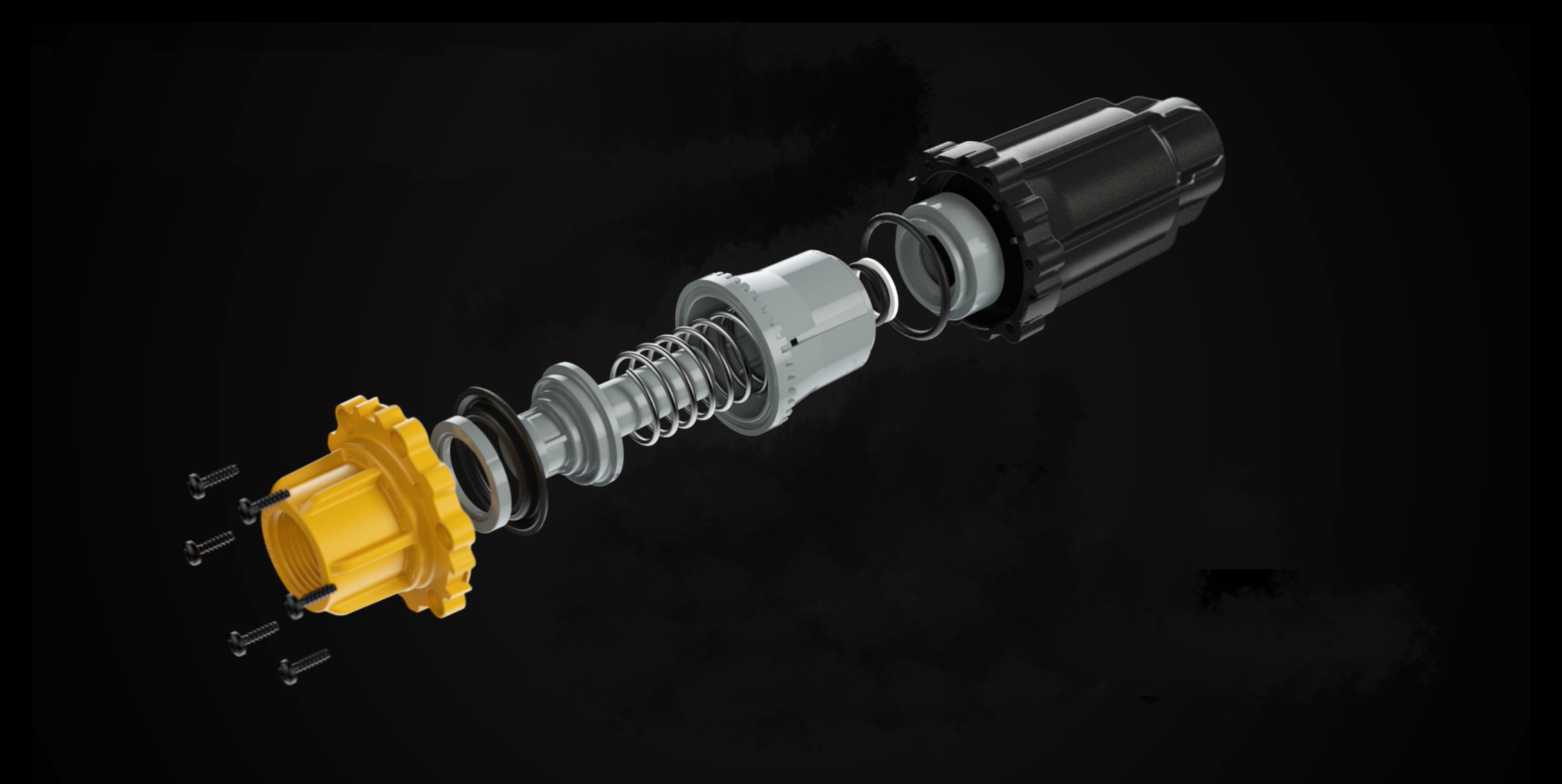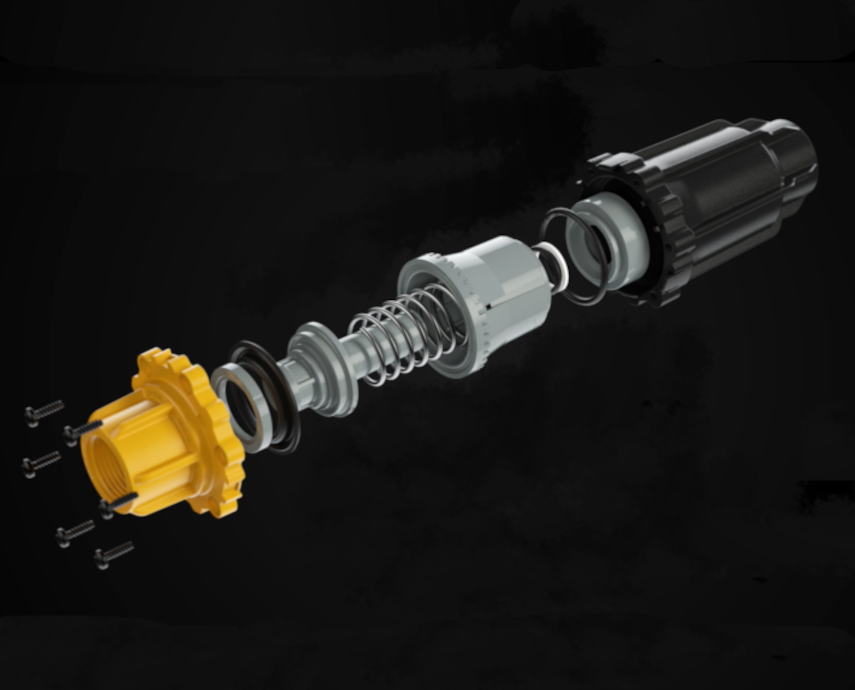El Komet Precision Regulator (KPR-X) domina los problemas más frecuentes de reguladores de presión -atascamiento, desgaste, rendimiento. Su diseño pionero, en combinación con materiales de alta calidad, hace del KPX-R un componente duradero e indispensable de una máquina de irrigación.
Control de presión
a nivel superior
Komet
Precision Regulator
(KPR-X)
El objetivo central de un regulador Pivote consiste en mantener una presión de salida constante, a pesar de presiones variables de entrada, conservando esta fiabilidad durante muchos períodos de cultivo. El Komet Precision Regulator (KPR-X) asegura, debido a su diseño innovador y su construcción ingeniosa, una regulación de presión fiable y de alto rendimiento.
Los materiales usados para el Komet Precision Regulator (KPR-X) son sometidos durante todo el proceso de fabricación a un meticuloso control de calidad. Además cada componente crítico es probado 100% individualmente en la línea de producción de precisión totalmente automática.
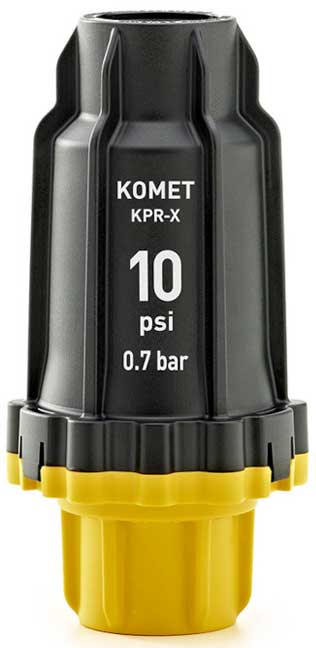
- Gama de caudales definido por la gama de boquillas
- 1.6 - 10.3 mm
8 - 52 1/128"
- con gama de presiones
- 0.4 - 1.4 bar
6 - 20 psi
All-Flow Regulador de presión
Modelos Disponibles
KPR-X
All-Flow
6 PSI


KPR-X
All-Flow
10 PSI
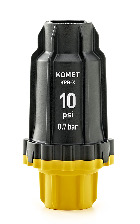

KPR-X
All-Flow
15 PSI


KPR-X
All-Flow
20 PSI
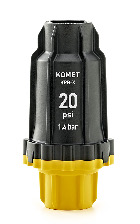

Download
Catálogo
Komet Pivot Sprinkler
Información técnica
Instrucciones de Uso KPR-X
Sprinkler System Pressure Regulator
What it does, and why you need it
Sprinkler system pressure regulators are the unsung heroes of any efficiently working center pivot irrigation system. Pressure regulators are flow control devices whose task it is to equalize the pressure of the water that is supplied to each individual sprinkler. Pivot nozzles are manufactured to operate within a predetermined range of flows and pressures. As long as the water pressure stays within the designed range, the pivot nozzles are able to deliver the distribution pattern, throw radius and droplet size for which they were designed. Installing a pressure regulator on a sprinkler system therefore not only allows each sprinkler to perform exactly how it was intended, but also counteracts premature wear – thus ensuring a longer lifespan of the installed equipment, and helping growers make the most of their investment. A sprinkler system pressure regulator is also a key component for achieving uniform water application along the entirety of the center pivot or linear machine. This results in greater operational efficiency (translating into lower energy costs), increases crop productivity, and prevents water waste – a factor that is becoming increasingly topical in today’s cost-intensive and resource-conscious world. In addition, installing a pressure regulator on your sprinkler system also helps prevent leaks and emitter blowouts.
Furthermore, sprinkler system pressure regulators are highly relevant when it comes to the application of chemicals for the enhancement of crop productivity: inconsistent pressure within a sprinkler system can lead to an uneven application of pesticides and fertilizers, which would have a negative effect on plant growth and, consequently, reduce the volume of the final yield.
While any sprinkler system will greatly benefit from pressure regulation (both in terms of operational efficiency and yield volume), installing a sprinkler system pressure regulator is yet more vital in low-pressure systems, where even the slightest pressure variation can significantly impact the pivot nozzles’ application rate. For example, if a sprinkler was designed to operate at 10 psi (0.69 bar), a pressure variation of 2 psi (0.14 bar) is equivalent to 20%, altering the flow by approximately 10%. Other scenarios that require an adjustable pressure regulator in order to deliver optimal results include (but are not limited to):
- Sloping or uneven terrains (as an elevation difference between the individual pivot nozzles installed along the sprinkler system is among the most common causes of pressure variations)
- Any scenario in which the pivot nozzles installed on the first few spans of the pivot system are supplied with water at an excessively high pressure
- Situations where there is friction loss within the pipeline (which can result in significant differences in water pressure)
- Any sprinkler system in which one pump supplies more than one set of sprinklers
With the Komet Precision Regulator KPR-X, Komet Irrigation offers a top-of-the-range sprinkler system pressure regulator whose high-quality materials and ingenious construction make it the most effective product of its kind currently on the market. The Komet Precision Regulator KPR-X is distinguished by an axial design – which allows for a concentrical arrangement of its components. Flow deviation fins evenly direct the water towards the center of the device, whose large inlet chamber enables an optimal inlet flow to accommodate all nozzle sizes (8 – 52 /128”). The flow force is applied to the plunger in a uniform manner, thereby counteracting one-sided wear.
The KPR-X’s optimal plunger diameter allows for the largest possible gap between valve seat and plunger – facilitating an unimpeded flow and, consequently, reducing the risk of plugging. A progressive dampening system in the KPR-X’s diaphragm chamber minimizes friction, and ensures low hysteresis for a continuously smooth operation. The diaphragm chamber will adapt to existing conditions and compensate for phenomena such as water hammers in order to limit pressure fluctuations.
In addition, Komet’s KPR-X sprinkler system pressure regulator features a self-cleaning mechanism, whereby sand and debris are flushed out automatically to keep the entire sprinkler system working at peak performance.
Optimizing your Sprinkler System
Getting it right: Installing a pressure regulator on sprinkler system set-ups
There are numerous reasons why variations in a mechanized irrigation system’s flow rate can occur. They can be caused by the previously mentioned differences in elevation throughout the field, friction loss within the pipeline, or even the on/off cycle of an end-of-system gun: when the end gun is turned off, the extra capacity of the pump will generate a higher pressure in the system. This can lead to uniformity issues – which can have a detrimental effect on both crop health and soil integrity – and increase operating costs. If the pressure is too low, the amount of water reaching the far end of the pivot may be insufficient. If the pressure is too high, the running costs will increase unnecessarily.
To ensure an optimal pressure and consistent application of water for healthy, thriving crops, sprinkler system pressure regulators can be installed above each pivot nozzle along the sprinkler system. Thanks to its unique, patented design, the Komet Precision Regulator KPR-X promotes an unimpeded water flow which significantly reduces plugging. In addition to individual testing of all critical components, the KPR-X sprinkler system pressure regulator is subject to meticulous quality controls at every stage of Komet’s high-precision manufacturing process.
The KPR-X must be installed downstream from all shut-off valves, and will operate at the preset operating pressure over the whole nozzle range provided that the inlet pressure is at least 5 psi higher than the nominal rated pressure.
Whether you are designing a new sprinkler system, re-nozzling or integrating a pressure regulator into an existing set-up, Komet’s sprinkler design software can prove an extremely useful aid: With this internet-based pivot software, growers are able to map the layout of their pivot system and carry out highly accurate sprinkler chart calculations on the basis of key parameters, such as the type of U-pipe, pivot nozzles, length, diameter and outlet of the pivot or linear spans, along with hydraulic data, such as flow, the available pressure at the base and required pressure at the end of the irrigation system, or the elevation difference between the center and the highest irrigated point.
The pressure of your mechanized irrigation system should either be checked on a regular (weekly or bi-weekly) basis, or monitored continuously via a pressure gauge in order to maintain optimum efficiency of your sprinkler system, and minimize your overall irrigation costs.

